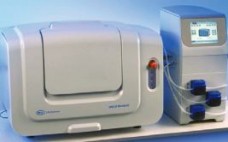The cell therapy industry is undergoing a natural evolution from scientific curiosity into a commercially and clinically attractive opportunity (1). This evolution is by no means complete, and growing evidence suggests that its progression is driving significant developments in cell therapy bioprocessing — notably, convergence. Table 1: 194; () Progressively, bioprocessing technologies primarily used in production of noncell-based products are being evaluated for cell therapy bioprocessing applications (2). Consequently, this process of convergence is leading to an increasing proportion of…
Manufacturing
Activatable Immunoconjugates for Target Cancer-Cell–Specific Diagnosis and Therapy
In cancer treatment, early diagnosis and targeted therapies are assumed to yield the highest cure rates. However, most current methods are limited by their low sensitivity to early disease and a lack of specificity for targeted cell killing. Newly developed, activatable immunoconjugates assist in the accurate detection of cancer through in vivo imaging with high target-to-background contrast (1,2). They also provide for the possibility of highly specific, light-mediated treatment with minimal effects on healthy cells surrounding tumors (3). In fact,…
Cell Therapy Manufacturing
Fueled by a recent resurgence in public financing and compelling clinical data for indications as diverse as acute macular degeneration and pancreatic cancer, a growing number of cell therapies are driving toward pivotal clinical studies and commercialization. Although regulatory precedents have been set for various autologous and allogeneic products in the United States, Asia, and the European Union, regulatory guidance continues to evolve for a widening array of cell products. Adult stem cells (e.g., mesenchymal stem cells), embryonic stem cells,…
Accelerating Purification Process Development of an Early Phase MAb with High-Throughput Automation
Monoclonal antibodies (MAbs) are the fastest growing segment in the biopharmaceutical industry because they are potentially efficacious in the treatment of diseases such as cancer and autoimmune disorders (1,2). With steadily increasing demand for efficient and affordable therapies, speed to clinic/market is important, and biopharmaceutical companies push multiple drugs into development each year to ensure business sustainability (3,4,5,6). Downstream purification process development for therapeutic MAbs is a critical step on their path to reach clinical trials and beyond…
Single-Use, Continuous Processing of Primary Stem Cells
Many potentially therapeutic products involve the culture of stem cells. Their commercial success depends on the development of scalable good manufacturing practice (GMP) technologies that can both robustly and cost-effectively produce very large numbers of cells. Through many improvements and innovations in bioprocessing operations over the years, fed-batch suspension culture has remained the most common mode for large-scale biopharmaceutical manufacturing. However, some recent events suggest that may be changing (1,2). For the culture and expansion of stem cells, large-format adherent…
Single-Use Bioreactors and Microcarriers
Cell-based therapies hold promise for treating many acute and chronic diseases (1). Optimism surrounding that therapeutic potential has driven the initiation of multiple clinical trials in pursuit of such treatments. Procedures for preparing these therapeutic agents begin with selective isolation of cells from desired tissues. That is followed by ex vivo expansion of cells of desired phenotype and functionality. Once expanded to acceptable levels, cells are stored to preserve their viability during transportation to treatment facilities. The final step in…
Effective Cryopreservation and Recovery of Human Regulatory T Cells
The list of conditions being targeted by cell therapies is rapidly growing, but commercializing cells for widespread medical use will require standardized laboratory practices. Development processes must be adapted specifically for cell-based drug products. Regulatory T-cell therapy represents a promising new frontier in the immunotherapy of autoimmune disorders, especially for patients who have been refractory to available treatments. Because of intrinsic fragility, cell therapy products can be highly sensitive to variations in manufacturing procedures. Standardization of drug-product cryopreservation and storage…
Bioprocess Advances Drive Vaccine Manufacturing in Developing Countries
Advances in bioprocessing technology hardware and genetic engineering are expanding the geographic options for biologics manufacturing to include developing and emerging economies. Such advances are beginning to permit biopharmaceutical production in regions that previously lacked the technical expertise or quality processes to permit complex operations, monitoring, record-keeping, and oversight. Global demand by countries for in-country production of biological vaccines is increasing, so those products tend to be leading the way in terms of adoption of modern bioprocessing in developing countries.…
North, South, East, and West
Electrophoresis is the basis of all blotting methods, and BPI Lab covered it last month (1). Electroblotting is a method for transferring electrophoretically separated proteins or nucleic acids onto a polyvinylidene fluoride (PVDF) or nitrocellulose membrane for permanence using electric current and a transfer buffer solution. This allows for analysts to further study them using probes, ligands, or stains. Capillary blotting is a variation designed to work with capillary electrophoresis. After electrophoresis the following are stacked in cathode-to-anode order: a…
Enabling Technologies
Many technological advancements in recent years have enabled companies to shorten time to market, to better understand their manufacturing processes, and to characterize their products well. In BPI’s December 2013 issue (pages 47–50), I reported on the first half of an informal reader survey about those technologies, with commentary from some survey participants and others. This month concludes with my examination of analytical, formulation/fill–finish, and facilities technologies. Analytical Technologies After writing several installments of our new “BPI Lab” series this…

